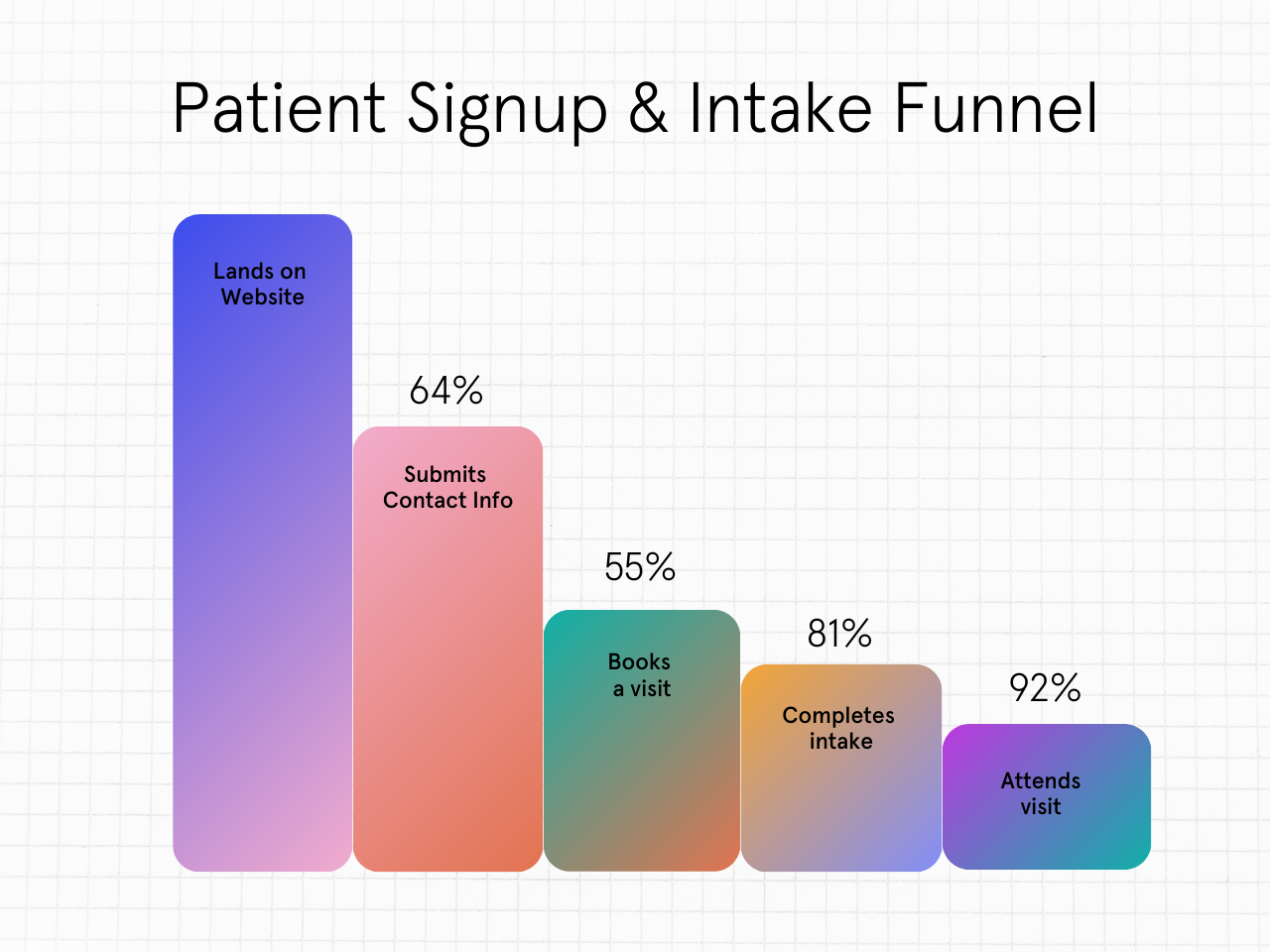Tracking the Right Metrics to Grow Your Healthcare Practice
Montana Scher

If you're growing a healthcare practice—whether you're running ads, building content, or investing in partnerships—you need to know what's working. But most teams only track part of the picture.
They know how many people clicked an ad or filled out a form. But what happens after that? Did the person complete their intake? Book an appointment? Show up?
To really understand performance, you need to track all the way from first visit to first appointment. That’s what we call activation—and it’s where most tracking falls apart.
Below are 8 best practices for tracking your funnel from end to end—so you can stop guessing and start growing smarter.
1. Track the Full Funnel (Not Just the Top)
Form submissions are useful, but they’re not enough. You need to track whether someone:
- Landed on your site
- Filled out a form
- Completed intake
- Booked an appointment
- Actually showed up
Tracking that last piece—did an appointment actually occur?—is often missing, but it’s critical. It’s how you know whether your marketing is attracting the right people and whether your onboarding flow is doing its job.
💡 Tools like Morf can help you track these events across systems, even when appointment and intake data live in your EHR.
2. Include Key Milestones in Onboarding
If intake forms are part of your new patient flow, you need to track:
- Completion rate
- Time to complete
- Where people drop off
A common worry is that long forms reduce conversion. But it’s not always true. At Parsley Health, we actually got feedback from patients that the extensive intake made them feel seen. In that case, the length was a strength—not a blocker.
The only way to know is to measure and to ask.
3. Go Beyond Lead Volume to Measure Fit
High lead volume doesn’t always mean high-quality patients. That’s why you should track deeper funnel events like:
- Appointment occurred
- Cancellation reason
- No-show rate
These signals help you understand if your marketing is attracting the right people—not just the most people. It also gives you valuable insight into where your onboarding or scheduling might be breaking down.
4. Track Leads You Can’t Serve (Yet)
Sometimes a patient doesn’t convert simply because you can’t help them today. Maybe they’re out of state, or you don’t take their insurance.
If you’re not tracking and segmenting these contacts, you’re missing future opportunities. Capture emails and surface reasons for drop-off so you can re-engage them when your footprint grows.
5. Track Appointment Availability
If someone reaches your scheduling page and doesn't book, is it a conversion issue—or was nothing available?
Tracking appointment inventory—i.e., what times were actually offered when someone tried to book—helps you understand how availability impacts conversion.
It can also surface unmet needs, like offering early morning or after-hours slots.
6. Automate Smart Follow-Ups
Some of the biggest conversion wins come from simple automation:
- Signup abandonment reminders via SMS or email
- Form completion nudges before visits
- Appointment reminders, especially via SMS (better than email for reducing no-shows)
These don’t just improve conversion—they improve the experience. Patients feel guided and supported, not left hanging.
7. Stay HIPAA-Compliant with Your Tracking
Be careful not to pass PHI or PII to analytics or ad platforms. Even something as simple as tracking form responses or appointment status can be sensitive.
Morf supports server-side, HIPAA-compliant conversion tracking, so you can get the insights you need without compromising compliance.
8. Talk to People Who Didn’t Convert
No analytics tool can replace a good conversation.
Reach out to a handful of prospective patients who didn’t book—offer a gift card or a free consult in exchange for 15 minutes of their time.
Things we’ve heard from customers through this process:
- “I couldn’t find a time that worked”
- “I wanted to switch to virtual but didn’t see the option”
- “I wasn’t sure if my insurance would be accepted”
These conversations often surface the real blockers—ones you won’t see in a dashboard.
How Morf Can Help
Tracking the full patient funnel across intake forms, EHRs, and scheduling tools isn’t easy—especially when you’re trying to stay HIPAA-compliant.
Morf makes it simple. We help healthcare teams:
- Track and automate onboarding flows
- Capture every touchpoint—from signup to appointment
- Send SMS/email reminders
- Sync data across tools without manual work
- Get visibility into each patient’s full journey
We help you ensure you have the data you need to understand and improve your business.
📈 Ready to optimize your funnel without compromising experience or compliance? Reach out to us at friends@morf.health